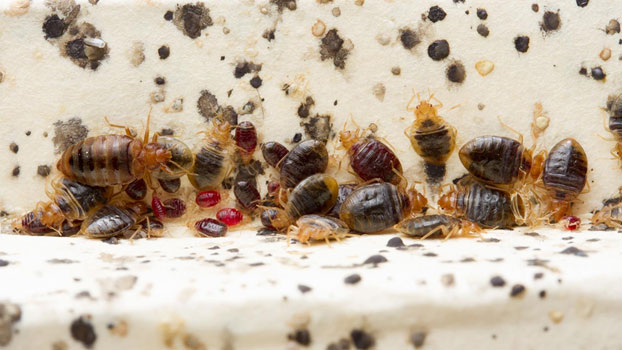A1 Bed Bug Treatment Houston for Dummies
A1 Bed Bug Treatment Houston for Dummies
Blog Article
The Best Guide To A1 Bed Bug Treatment Houston
Table of ContentsThe smart Trick of A1 Bed Bug Treatment Houston That Nobody is Talking AboutThe Facts About A1 Bed Bug Treatment Houston RevealedA1 Bed Bug Treatment Houston Things To Know Before You Get ThisOur A1 Bed Bug Treatment Houston PDFsThe Single Strategy To Use For A1 Bed Bug Treatment HoustonThe Best Guide To A1 Bed Bug Treatment Houston
Bed bugs are blood-sucking pests of the order hemiptera. Unlike insects or ticks, bed pests do not send conditions. Bed pest attacks can trigger allergic reactions, secondary bacterial infections (such as impetigo, ecthyma, and lymphangitis) and mental wellness issues (such as anxiety and sleeping disorders). In recent times, insect control organizations have actually enhanced their bed bug control services.Male and women grownups become engorged in about 10 to 15 minutes; they normally feed every 3 to 4 days, yet they can live over a year without feeding. Each female can lay up to 5 eggs per day and concerning 500 eggs in their life time.
The 10-Minute Rule for A1 Bed Bug Treatment Houston

Bat bugs are ectoparasites of bats and birds (see Number 3). Ectoparasites reside on the exterior of the host. They are typically found in the attic or walls when bats exist. Bat insects migrate if they can not discover their favored host and they easily attack people. The various other varieties of bed pests are not normally discovered in Pennsylvania.
Number 3 (right): The other bed bug located in Pennsylvania is the Eastern bat insect. A1 Bed Bug Treatment Houston. Picture: Mohammed El Damir, Bed bugs conceal throughout the day and avoid locations with motion and light throughout the night.
The 10-Minute Rule for A1 Bed Bug Treatment Houston
In apartment, bed bugs can relocate from one home to an additional vertically and flat. Long-distance infestations take place when ravaged objects such as bed linen, furniture, or packaging materials are relocated to brand-new locations. Travelers can transport bed pests back and forth in clothing, luggage, and laptop or tablet instances.
Surveillance is a crucial tool for a successful IPM program for bed pests. It is made use of to spot or review infestation levels previously, throughout, and after therapies of IPM programs. Proper identification is necessary prior to beginning any kind of bed insect therapy due to the fact that client-made recognitions are frequently undependable. Bed pests are occasionally misinterpreted for ticks, fleas, roaches, rug beetles, or other home bugs.
Bed bug surveillance is necessary to estimate the problem level prior to control and the treatment effectiveness after control. The following are kinds of bed pest surveillance approaches. Aesthetic assessments have a discovery rate of 72 percent. Experts carry out these evaluations to figure out infestation locations and levels of problem before starting therapy for bed pests or to examine efficacy after therapy.
Not known Details About A1 Bed Bug Treatment Houston
Assessors ought to look for reddish-black spots, eggs, lost "skin" of larval bed pests, and immature and grown-up bed insects in their environment near human relaxing areas such as beds, sofas, and recliners (see Number 5). In enhancement, the wonderful and stuffy smell produced by bed bug waste is particular of a modest to high degree of infestation.
Image: Garo Goodrow, Penn State Bed bug sniffing pets can spot bed pests with a 97 percent rate of precision. They can site here detect all bed insect life phases in low and high infestations. Canines are educated by the association of benefit systems to discover bed bug smells. They look on the most typical areas where bed insects can be located.
When dogs spot bed insect odors, they signal their handler that confirms by visual inspection. Canines are a lot more reliable than people due to the fact that pets discover bed insects in locations without sight such as inside walls, behind baseboards, and in furniture - A1 Bed Bug Treatment Houston. Interceptor cups, which have a discovery rate of 89 percent, are the most common devices
What Does A1 Bed Bug Treatment Houston Do?
Number 6: Interceptor cups made use of to catch bed insects. Image: Parker Goodrow, buddy of Penn State In enhancement, interceptor mugs are likewise made use of to review treatment efficiency and to safeguard beds from bed bugs.
Solidified carbon dioxide can be used to generate the CO2. Figure 8: Digital tracking tools used to bring in and catch bed pests. Picture: David P. James, Flickr (used with approval) When both aesthetic assessment and interceptors are used for monitoring bed bugs, the detection price increases to 99 percent. This method is taken into consideration the most affordable method for carrying out building-wide evaluations for bed insects.

5 Simple Techniques For A1 Bed Bug Treatment Houston
Mechanical control is not harmful, is environment-friendly, and does not require a re-entry period (time that should pass in between the chemical application and the time that individuals can go look at this web-site back to see this that area without protective clothing and devices). Nonetheless, mechanical control does not have a residual impact so re-infestation of bed pests can happen.
As an alternative, clothes dryers alone can eliminate bed pests when made use of at a high temperature for 15 to 30 minutes. Temperatures of 131 F or above are deadly to all bed pest phases.
Report this page